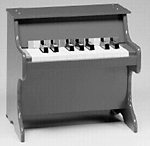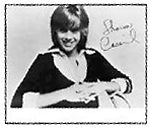Since moving into a new bachelor pad, I’ve tackled the challenge of eliminating clutter from my home. Downsizing from a two-story house to a one-bedroom apartment dictated severe pruning of my record, CD, and book collections. Although I am sad to see my Jim Nabors LPs returned to the Goodwill locations from whence they came, this enforced purge came just in time. An overabundance of material possessions was exerting an unhealthy influence on my disposition. Even though feng shui is just one more excuse for folks not to take responsibility for their own destinies, I firmly believe that the maintenance of open space in one’s abode encourages peace of mind and good nature.
And so grocery bags were packed till they overflowed with long-neglected stuffed animals, Charlie’s Angels trading cards, and 10-packs of Three’s Company stickers. With a kiss goodbye, I handed my dusty Cheryl Ladd doll her walking papers. New Kids on the Block marbles, Lamb Chop bendable figurines, a slew of Christmas 8-track tapes—I breathe easier now that they’re gone. I’m even down to a mere three toy pianos.
That last cutback may not seem impressive, but previously I’d had a dozen of these miniature instruments. Now I’ve systematically eliminated all but the finest specimens. I showed no mercy for those with missing legs or the late-model ones where pictures of barnyard animals popped up when you depressed their clanking metal keys. Only a trio of true beauties—two tiny grands and a medium-sized upright, all fashioned to resemble the genuine article—was spared.
My fascination with these itty-bitty Steinways dates back to when I interviewed Margaret Leng Tan about her 1997 album The Art of the Toy Piano (Point Music). At first, I dismissed this New York performer’s specified oeuvre as a gimmick. But after hearing her renditions of works by Beethoven, Glass, Satie, and others, I changed my tune. (I’m not alone in reversing my opinion, either. When I initially mentioned Leng Tan’s CD to Stephin Merritt of the Magnetic Fields, he snorted derisively at the concept; he’s since invited her to open shows for him, and she appears on a forthcoming record by his band the 6ths.)
For me, embracing the toy piano was a way of flipping the bird to my parents and instructors for all those fruitless years spent chained to the bench practicing scales and arpeggios and Chopin 鴵des because it was supposed to refine my musical character. This subversive little instrument actually rejects many of the qualities I found so frustrating about the model upon which it is based. The ideal for a “real” piano is the even temperament of 12 notes, reinforcing the importance of precise pitch—often at the expense of emotional expression—in Western classical tradition. Toy pianos, which produce tones by striking metal rods, not wires, with a hammer, can’t be tuned. Their black keys are often just painted stripes.
The timbre of these little gems actually recalls the gamelan (a Balinese percussion orchestra), which at the turn of the last century inspired one of my heroes, Claude Debussy, to buck compositional conventions and forge a bold new harmonic language via works like La mer and L’apr賭midi d’un faune.
The tinkling music of the toy piano evokes the uneasy balance between childhood and grown-up concerns, the carefree abandon of the nursery versus the regimented discipline of the parlor. When deployed by composers such as Catalan cabaret genius Pascal Comelade (who recently collaborated with P.J. Harvey on the soundtrack to Hal Hartley’s The Book of Life), they can generate tremendous emotional resonance for an instrument of such limited range.
Thus my heart leapt last week when I tore open a press release for France’s Toog (who opens for Momus and Kahimi Karie at ARO.space Tuesday, November 16) and read this quote from the BBC: “Imagine a 21st century descendent of French musical maestros Erik Satie and Serge Gainsbourg playing his compositions with chop sticks on a selection of synths and toy instruments and you have Toog.”
Sure enough, toy pianos abound on Toog’s new CD, 6633 (on Le Grand Magistery). But they’re used very discreetly, as is all the instrumentation here—even a chorus of barking pooches and a dentist’s drill. Amidst gentle but insinuating arrangements of synthesizer, flute, and strings, Toog softly intones surreal French lyrics about dental hygiene and overfeeding his pet fish. With minimal resources, he weaves a hypnotic spell that can lull the listener into whiling away hours on the sofa. 6633 makes doing nothing seem very important indeed. It won’t be going the way of my Jim Nabors wax anytime soon.






